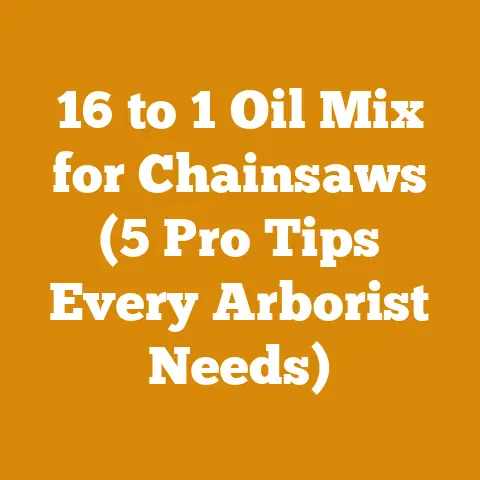576 XP Husqvarna Maintenance Tips (5 Pro Chainsaw Hacks)
Affordability is key when you’re working with wood, whether you’re felling timber, processing logs, or just trying to keep your home warm with firewood. Over the years, I’ve learned that a well-maintained chainsaw, especially a powerhouse like the Husqvarna 576 XP, can be your best friend – and a poorly maintained one, your biggest expense. Let’s delve into the world of Husqvarna 576 XP maintenance, focusing on keeping costs down and performance high. This isn’t just about saving money; it’s about working smarter, safer, and more efficiently.
576 XP Husqvarna Maintenance Tips (5 Pro Chainsaw Hacks): A Cost-Conscious Guide
The Husqvarna 576 XP is a workhorse, no doubt about it. But like any high-performance machine, it requires regular TLC to keep it running smoothly and avoid costly repairs. The following tips are designed to help you, whether you’re a seasoned logger or a weekend warrior, maintain your 576 XP like a pro, all while keeping your budget in check.
Hack #1: The Power of Preventative Maintenance – Your First Line of Defense
Preventative maintenance is the cornerstone of chainsaw longevity. Think of it as an investment, not an expense. It’s far cheaper to prevent problems than to fix them.
Regular Cleaning – A Must-Do After Every Use
-
The Air Filter: This is your engine’s first line of defense against dust and debris. A clogged air filter restricts airflow, leading to reduced power and increased fuel consumption. I’ve seen chainsaws practically choke themselves to death because of neglected air filters. According to Husqvarna’s own data, a dirty air filter can reduce engine power by up to 20%! I make it a habit to clean the air filter after every use, especially in dusty conditions. Use compressed air to blow it out from the inside, or wash it with warm, soapy water, ensuring it’s completely dry before reinstalling.
-
The Cooling Fins: These fins help dissipate heat from the engine. If they’re clogged with sawdust, the engine can overheat, causing damage. I use a stiff brush to clean the cooling fins regularly. Overheating can lead to premature wear of engine components.
-
The Bar and Chain: Clean the bar groove with a bar groove cleaner or a small screwdriver to remove sawdust and debris. Inspect the chain for damage and sharpen it regularly. A dull chain puts unnecessary strain on the engine and can be dangerous.
Fuel System Care – Avoid Costly Carburetor Repairs
-
Use Fresh Fuel: Old fuel can gum up the carburetor and cause starting problems. I always use fresh fuel, mixed with the correct ratio of high-quality 2-stroke oil. I never store fuel in the chainsaw for extended periods. Ethanol-blended fuels are notorious for causing problems in small engines. If you must use ethanol fuel, add a fuel stabilizer to prevent it from breaking down.
-
Fuel Filter Inspection: The fuel filter prevents debris from entering the carburetor. I inspect the fuel filter regularly and replace it as needed. A clogged fuel filter can starve the engine of fuel, causing it to run poorly.
-
Carburetor Adjustment: A properly adjusted carburetor ensures optimal engine performance and fuel efficiency. If your chainsaw is running poorly, it may need a carburetor adjustment. I always refer to the owner’s manual for the correct procedure. If you’re not comfortable adjusting the carburetor yourself, take it to a qualified technician. A poorly adjusted carburetor can lead to engine damage.
Data and Statistics:
- Air Filter Replacement Costs: A new air filter for a Husqvarna 576 XP typically costs between $10 and $20. Replacing it regularly is far cheaper than repairing a damaged engine.
- Carburetor Repair Costs: Carburetor repairs can range from $50 to $200 or more, depending on the extent of the damage. Preventative maintenance can help you avoid these costly repairs.
- Fuel Stabilizer Costs: A bottle of fuel stabilizer typically costs between $5 and $10 and can treat several gallons of fuel. This is a small price to pay to protect your engine from the damaging effects of ethanol.
Hack #2: Chain Sharpening – The Key to Efficiency and Safety
A sharp chain is not only more efficient, but it’s also safer. A dull chain requires more force to cut, increasing the risk of kickback.
Choosing the Right Sharpening Tools
-
Round File and File Guide: This is the most common method for sharpening chainsaw chains. I use a round file of the correct diameter for my chain, along with a file guide to ensure the correct angle and depth.
-
Electric Chain Sharpener: An electric chain sharpener can make sharpening faster and easier, especially if you have a lot of chains to sharpen. However, it’s important to use it correctly to avoid damaging the chain.
Sharpening Technique – Consistency is Key
-
Maintain the Correct Angle: The correct sharpening angle is crucial for optimal cutting performance. I always refer to the owner’s manual for the correct angle for my chain.
-
File Each Tooth Evenly: File each tooth the same number of strokes to ensure that all the teeth are the same length. Uneven teeth can cause the chain to cut unevenly.
-
Lower the Depth Gauges: The depth gauges control the amount of material that each tooth can remove. I lower the depth gauges periodically to maintain optimal cutting performance.
Data and Statistics:
- Chain Sharpening Frequency: I typically sharpen my chain after every few hours of use, or whenever it starts to feel dull.
- Chain Replacement Costs: A new chainsaw chain for a Husqvarna 576 XP typically costs between $30 and $50. Sharpening your chain regularly can extend its lifespan and save you money.
- Kickback Injuries: According to the Consumer Product Safety Commission (CPSC), kickback is the most common cause of chainsaw injuries. A sharp chain reduces the risk of kickback.
Hack #3: Bar Maintenance – Extending the Life of Your Guide Bar
The guide bar is an essential component of your chainsaw. Proper maintenance can extend its lifespan and prevent costly replacements.
Bar Cleaning and Lubrication – Keeping it Smooth
-
Clean the Bar Groove: The bar groove is the slot that the chain runs in. I clean the bar groove regularly with a bar groove cleaner or a small screwdriver to remove sawdust and debris. A clogged bar groove can restrict chain movement and cause premature wear.
-
Lubricate the Bar and Chain: Proper lubrication is crucial for reducing friction and extending the life of the bar and chain. I use a high-quality bar and chain oil and check the oil level frequently.
-
Check the Oiler: The oiler is responsible for lubricating the bar and chain. I check the oiler regularly to make sure it’s working properly. A malfunctioning oiler can cause the bar and chain to overheat and wear out quickly.
Bar Rail Maintenance – Preventing Premature Wear
-
Dress the Bar Rails: The bar rails are the edges of the bar that the chain rides on. I dress the bar rails periodically with a flat file to remove burrs and smooth out any imperfections.
-
Rotate the Bar: Rotating the bar periodically can help to distribute wear evenly and extend its lifespan.
Data and Statistics:
- Bar Replacement Costs: A new guide bar for a Husqvarna 576 XP typically costs between $50 and $100. Proper maintenance can help you avoid these costly replacements.
- Bar and Chain Oil Consumption: I typically use about one quart of bar and chain oil for every tank of fuel.
- Bar Rail Wear: Bar rail wear is a common problem that can be prevented with regular maintenance.
Hack #4: Understanding and Addressing Common 576 XP Issues
Even with the best maintenance, problems can still arise. Knowing how to diagnose and address common issues can save you time and money.
Starting Problems – Troubleshooting the Usual Suspects
-
Check the Spark Plug: A fouled spark plug can prevent the engine from starting. I check the spark plug regularly and replace it as needed.
-
Check the Fuel: Make sure you have fresh fuel in the tank and that the fuel filter is clean.
-
Check the Ignition System: If the spark plug and fuel are good, the problem may be with the ignition system. I check the ignition coil and wiring for damage.
Running Problems – Identifying the Root Cause
-
Check the Air Filter: A clogged air filter can cause the engine to run poorly.
-
Check the Carburetor: A poorly adjusted carburetor can cause the engine to run too rich or too lean.
-
Check the Exhaust System: A clogged exhaust system can restrict airflow and cause the engine to run poorly.
Data and Statistics:
- Spark Plug Replacement Costs: A new spark plug for a Husqvarna 576 XP typically costs between $5 and $10.
- Ignition Coil Replacement Costs: A new ignition coil for a Husqvarna 576 XP typically costs between $30 and $50.
- Exhaust System Cleaning Costs: Cleaning the exhaust system can cost between $20 and $50, depending on the extent of the clogging.
Hack #5: Long-Term Storage – Protecting Your Investment During Downtime
Proper storage is crucial for preventing damage to your chainsaw during periods of inactivity.
Preparing Your Chainsaw for Storage
-
Drain the Fuel Tank: Gasoline can break down and gum up the carburetor during storage. I always drain the fuel tank completely before storing my chainsaw.
-
Clean the Chainsaw: I clean the chainsaw thoroughly to remove sawdust and debris.
-
Lubricate the Bar and Chain: I lubricate the bar and chain with bar and chain oil to prevent rust.
-
Store in a Dry Place: I store my chainsaw in a dry place to prevent corrosion.
Data and Statistics:
- Fuel Degradation: Gasoline can start to degrade in as little as 30 days.
- Corrosion Prevention: Proper storage can prevent corrosion and extend the lifespan of your chainsaw.
- Storage Container Costs: A storage container for a chainsaw typically costs between $20 and $50.
The Cost of Neglect: A Personal Anecdote
I remember one particularly harsh winter where I was relying heavily on my 576 XP to keep my family warm. I was cutting firewood almost every day, and frankly, I got lazy with the maintenance. I skipped cleaning the air filter, didn’t bother sharpening the chain as often as I should have, and even neglected to properly lubricate the bar.
The inevitable happened. One cold morning, the chainsaw refused to start. After a frustrating hour of troubleshooting, I finally discovered that the carburetor was completely gummed up with old fuel. The repair cost me over $150, and I was without a chainsaw for several days. That experience taught me a valuable lesson: preventative maintenance is always cheaper than repairs.
Understanding the Variable Costs of Wood Processing
Beyond chainsaw maintenance, several other factors influence the overall cost of wood processing and firewood preparation. Let’s break down some of the most significant variables.
Wood Species and Quality
The type of wood you’re working with has a major impact on costs. Hardwoods like oak and maple are denser and require more effort to cut and split than softwoods like pine and fir. This translates to increased fuel consumption, more wear and tear on your chainsaw, and potentially higher labor costs if you’re paying someone to do the work.
- Hardwoods: Typically more expensive to purchase or harvest, require more energy to process, but offer higher BTU (British Thermal Units) content when burned as firewood.
- Softwoods: Easier to process, but lower BTU content means you’ll need more of it to generate the same amount of heat.
Location and Accessibility
The location of the wood source and its accessibility also play a significant role in costs. If you’re harvesting timber from your own property, you’ll save on purchase costs, but you’ll still need to factor in the cost of felling, skidding, and transporting the logs. If you’re purchasing timber, the price will vary depending on the region, the availability of wood, and the transportation costs.
- Remote Locations: Higher transportation costs due to fuel consumption and potential road maintenance.
- Difficult Terrain: Increased labor costs and potential equipment rental fees for specialized machinery.
Seasonality
The time of year can also affect wood processing costs. During the winter months, timber harvesting can be more challenging due to snow and ice. Firewood prices typically increase during the fall and winter as demand rises.
- Winter Harvesting: Increased risk of accidents and potential for equipment damage due to cold weather.
- Peak Season Demand: Higher prices for firewood and potentially longer lead times for equipment rentals.
A Deep Dive into Cost Components
Let’s break down the specific cost components involved in wood processing and firewood preparation.
Timber Purchase or Harvesting Costs
- Timber Purchase: Prices vary widely depending on species, quality, and location. According to the USDA Forest Service, the average stumpage price (the price paid for standing timber) for sawtimber in the United States in 2023 was around \$300 per thousand board feet (MBF), but this can range from \$100 to \$500 or more depending on the species and region.
- Harvesting Costs: Include felling, skidding, and transporting logs. These costs can range from \$50 to \$150 per MBF, depending on the terrain and the equipment used.
Tool Maintenance and Repair
- Chainsaw Maintenance: As we’ve discussed, regular maintenance is crucial for keeping your chainsaw running smoothly and avoiding costly repairs.
- Equipment Repair: Unexpected repairs can be a significant expense. It’s a good idea to set aside a contingency fund for equipment repairs.
Labor Wages
- Logging Crew: If you’re hiring a logging crew, labor costs will be a significant expense. According to the Bureau of Labor Statistics, the median hourly wage for logging workers in the United States in May 2023 was \$21.34.
- Firewood Handlers: If you’re hiring someone to help you process and stack firewood, labor costs will also be a factor.
Permits and Regulations
- Timber Harvesting Permits: In some areas, you may need a permit to harvest timber.
- Environmental Regulations: You may also need to comply with environmental regulations, such as erosion control measures.
Fuel and Oil
- Fuel Consumption: Chainsaws and other wood processing equipment consume a significant amount of fuel.
- Bar and Chain Oil: Proper lubrication is essential for extending the life of your chainsaw bar and chain.
Transportation
- Hauling Logs: Transporting logs from the harvest site to the processing location can be a significant expense.
- Delivering Firewood: If you’re selling firewood, you’ll need to factor in the cost of delivering it to your customers.
Industry Benchmarks and Statistical Data
Here are some current industry benchmarks and statistical data related to wood processing and firewood preparation:
- Average Price per Cord of Firewood: According to the Hearth, Patio & Barbecue Association (HPBA), the average price per cord of firewood in the United States in 2023 was around \$250, but this can range from \$150 to \$400 or more depending on the region and the type of wood.
- Average Drying Time for Firewood: Firewood typically needs to dry for at least six months to reach a moisture content of 20% or less. The drying time will vary depending on the species of wood, the climate, and the stacking method.
- Average BTU Content of Different Wood Species: Hardwoods like oak and maple have a higher BTU content than softwoods like pine and fir. This means that you’ll need less hardwood to generate the same amount of heat.
Cost Optimization and Budget Management Tips
Here are some practical tips for cost optimization and budget management in wood processing and firewood preparation projects:
- Plan Ahead: Develop a detailed plan for your project, including a budget and a timeline.
- Shop Around: Get quotes from multiple suppliers for timber, equipment rentals, and labor.
- Negotiate Prices: Don’t be afraid to negotiate prices with suppliers.
- Do it Yourself: If you have the skills and the time, consider doing some of the work yourself.
- Maintain Your Equipment: Regular maintenance can help you avoid costly repairs.
- Use Fuel-Efficient Equipment: Choose equipment that is fuel-efficient to reduce your fuel costs.
- Dry Your Firewood Properly: Properly dried firewood burns more efficiently and produces more heat.
- Sell Your Excess Firewood: If you have more firewood than you need, consider selling the excess to recoup some of your costs.
Relevant Calculations and Formulas
Here are some relevant calculations and formulas that can be helpful in wood processing and firewood preparation:
- Calculating Volume of Logs in Board Feet: Board feet = (Length in feet x Width in inches x Thickness in inches) / 12
- Calculating Volume of Firewood in Cords: A cord of firewood is a stack that measures 4 feet high, 4 feet wide, and 8 feet long, or 128 cubic feet.
- Estimating Drying Time Based on Moisture Content: Drying time depends on wood species, initial moisture content, and climate. A general rule of thumb is 6-12 months for hardwoods in a well-ventilated area.
Visual Elements: Cost Comparison Table for Logging Tools
| Tool | Purchase Price (Approx.) | Maintenance Cost (Annual) | Fuel/Energy Cost (Annual) | Labor Cost (If Applicable) | Total Annual Cost (Approx.) |
|---|---|---|---|---|---|
| Chainsaw (Husqvarna 576 XP) | \$800 – \$1,000 | \$50 – \$100 | \$100 – \$200 | \$0 (DIY) | \$950 – \$1,300 |
| Chainsaw (Husqvarna 576 XP) | \$800 – \$1,000 | \$50 – \$100 | \$100 – \$200 | \$500 (Hired Help) | \$1,450 – \$1,800 |
| Manual Log Splitter | \$200 – \$400 | \$10 – \$20 | \$0 | \$0 (DIY) | \$210 – \$420 |
| Hydraulic Log Splitter | \$1,500 – \$3,000 | \$100 – \$200 | \$50 – \$100 | \$0 (DIY) | \$1,650 – \$3,300 |
| Logging Truck Rental | N/A | N/A | N/A | N/A | Varies Greatly |
Note: Costs are estimates and can vary depending on location, usage, and other factors.
Actionable Takeaways and Next Steps
Here are some actionable takeaways and next steps for readers planning wood processing or firewood projects:
- Assess Your Needs: Determine the scope of your project and the resources you’ll need.
- Develop a Budget: Create a detailed budget that includes all of the cost components.
- Gather Information: Research timber prices, equipment rental fees, and labor rates in your area.
- Maintain Your Equipment: Regular maintenance can help you avoid costly repairs and extend the lifespan of your equipment.
- Stay Safe: Always follow safety precautions when working with wood processing equipment.
Conclusion: A Penny Saved is a Penny Earned
Ultimately, successful wood processing and firewood preparation comes down to careful planning, diligent maintenance, and a willingness to learn. By understanding the various cost components and implementing the tips outlined in this article, you can keep your expenses under control and enjoy the fruits (or rather, the firewood) of your labor. Remember, a penny saved is a penny earned, especially when you’re working with wood. So, keep your chain sharp, your engine clean, and your budget balanced!






